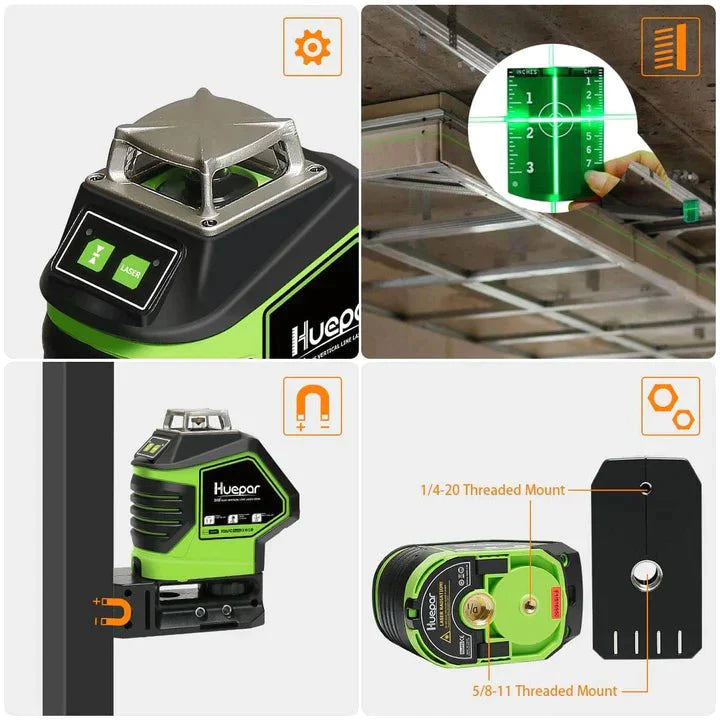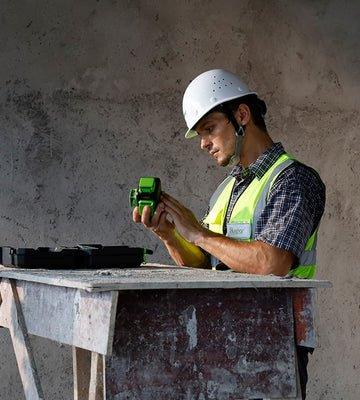Understanding Laser Levels and Their Types
What Is a Laser Level?
A laser level is a tool that emits a straight, level laser beam. This beam helps in aligning and leveling tasks. It has become a go-to device for construction, carpentry, and DIY home projects. A high-quality laser level ensures a perfect, level line every time. It replaces traditional tools like spirit levels. Modern laser levels are simple to use and offer high precision. You can find many types, such as 3d laser levels, cross line, and 4D models.

Different Types of Laser Levels
Laser levels come in various types, each designed for specific tasks. The main types include:
- Dot Lasers: Project simple dots on surfaces. Great for transferring points.
- Line Lasers: Emit horizontal or vertical lines. Used for aligning at one level.
- Cross Line Lasers: Produce intersecting lines. Perfect for right angles.
- Rotary Lasers: Cast a rotating line 360 degrees. Ideal for outdoor use.
- 3D Laser Levels: Project lines in three planes. For full-room layout.
- 4D Laser Levels: Advanced models with added features.
Each type offers unique benefits for construction and home projects.
Cross Line Laser Levels vs. Rotary Laser Levels
In the world of leveling tools, cross line and rotary laser levels stand out. Both have unique features for different tasks. Cross line lasers project intersecting horizontal and vertical lines. They are great for indoor work such as hanging pictures or tiling. Rotary lasers emit a rotating 360-degree beam. They work well outdoors for site layout or grading. Choosing depends on the job's scope and the precision needed.
An In-depth Look at 3D Laser Levels
How 3D Laser Levels Work
3d laser levels project lines on all planes, creating a 3D layout on worksites. They combine horizontal and vertical beams to form a cross line. This helps in marking, aligning, and leveling in three dimensions. The device emits lasers that form visible lines on surfaces. These lines are used as a guide for precise work. A 3D laser level often has a self-leveling feature. This means it can adjust to create straight lines, even on uneven surfaces. This tech lets users work more quickly and with better accuracy. Most 3D levels also come with various mounts and accessories. These allow the user to set up the level in multiple places with ease.
Benefits of Using a 3D Laser Level
3d laser levels offer enhanced efficiency and precision in various tasks. Their versatility allows users to tackle complex projects with greater ease. Benefits include improved accuracy, time-saving capabilities, and user-friendliness. These levels provide a full 360-degree layout, eliminating the need for constant repositioning. They are ideal for indoor applications, offering clear, visible lines, even in bright conditions. With the ability to project lines on all planes, they reduce the margin for error, making them a valuable tool for professionals seeking flawless results.
Typical Applications for 3D Laser Levels
3d laser levels are versatile tools widely used across various industries. Here are common applications:
- Construction: For laying out floors, walls, and ceilings with exact alignment.
- Installation: Essential for cabinetry, shelving, and tiling, ensuring everything is level and plumb.
- Electrical Work: Helps in accurately setting up electrical outlets and fixtures.
- Plumbing: Aids in installing pipes and plumbing systems precisely.
- Landscaping: Useful for setting out level ground and slopes for drainage systems.
- Carpentry: Helps to perfectly align structures like staircases, trims, and moldings.
3d laser levels offer accuracy and efficiency, making them a top pick for professionals to achieve precise results in their projects.
Choosing and Using Laser Levels Effectively
How to Choose the Right Laser Level for Your Needs
Choosing the right laser level is key to ensuring accuracy in your projects. To select the best one, consider these factors:
- Project Type: Determine if you need a cross line, rotary, or 3D/4D laser level based on the complexity of your work.
- Accuracy Requirements: Check the level's precision specifications and make sure they meet your needs.
- Range and Visibility: Look at the working range and laser visibility, especially if you'll work outdoors.
- Durability: Consider the construction environment and choose a level that can withstand it.
- Ease of Use: Make sure the level is easy to set up and operate, with clear indicators.
- Battery Life: For convenience, opt for models with long-lasting battery life.
By focusing on these aspects, you'll find a laser level that fits your specific requirements, making your projects run smoother and more efficiently.
The Advantages of 4D Laser Levels Over Traditional Models
4D laser levels offer significant advantages over traditional models. Firstly, they project lines in 360 degrees. This allows users to cover all angles without moving the tool. They also have improved accuracy for complex tasks. 4D models often come with enhanced features, like Bluetooth connectivity. This lets users control the device remotely. Additionally, they have better battery life and durability. Some even have green lasers for better visibility. Overall, 4D laser levels provide efficiency and precision in various settings.
Tips and Best Practices for Using Laser Levels
- Read the Manual: Always start by reading the user manual. It helps you understand your laser level's features.
- Calibrate Regularly: To ensure accuracy, calibrate your laser level as advised by the manufacturer.
- Check the Battery: Before starting a job, make sure the laser level's battery is fully charged.
- Use on Stable Surface: Place the laser level on a stable surface to avoid any disruptions in the laser line.
- Clean the Lens: Keep the laser lens clean for a clear, sharp laser line.
- Avoid Direct Eye Exposure: Never look directly into the laser beam to prevent eye damage.
- Store Properly: When not in use, store the laser level in its case to protect it from damage.
- Practice Safety: Always follow safety guidelines to prevent accidents while using the laser level.









